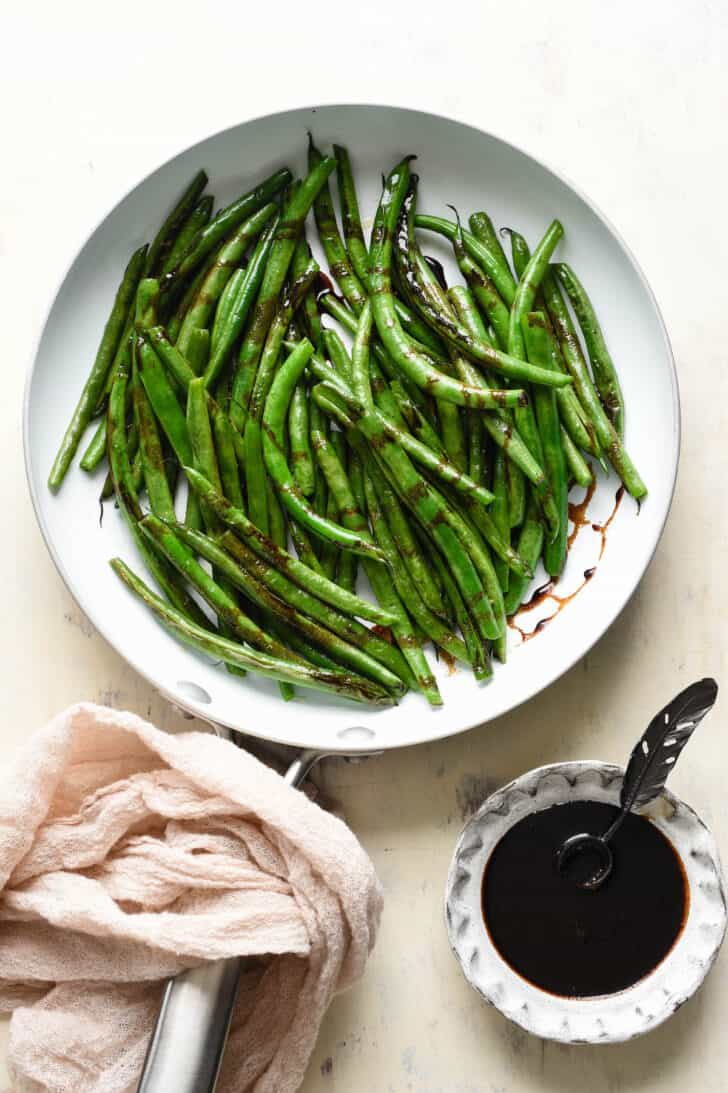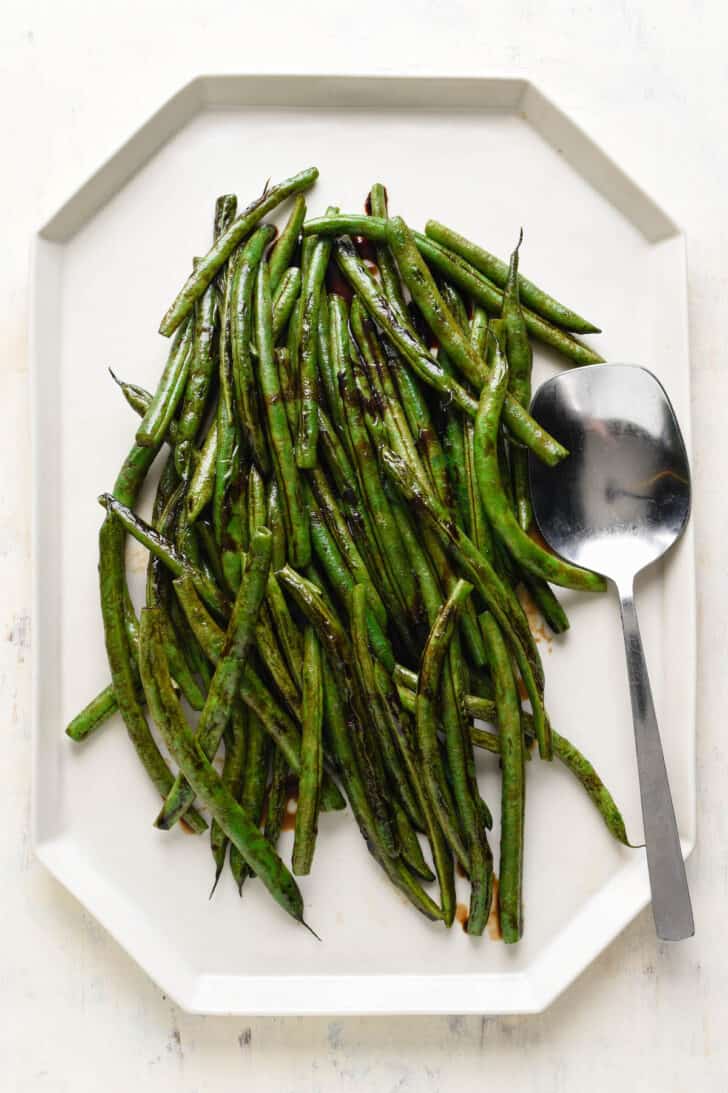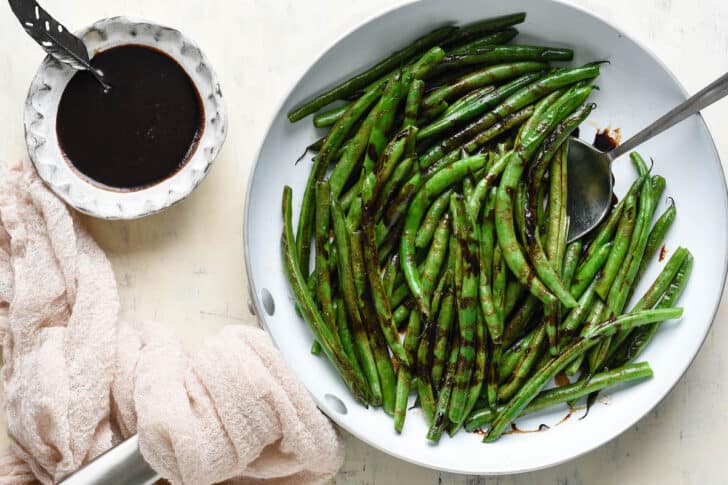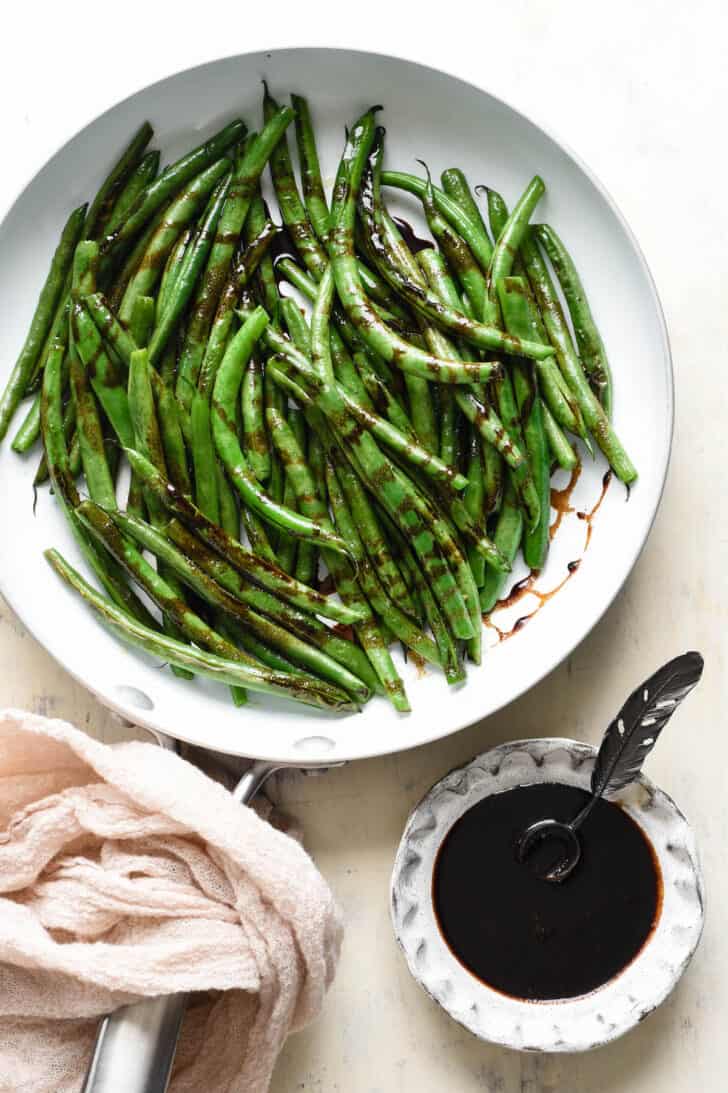Balsamic Glazed Green Beans
Balsamic Green Beans are a bright and tangy side dish that go well with just about anything. With just a few ingredients, you can make a special addition to a holiday dinner or any weeknight.

Take Green Beans To A Whole New Level
I make a pretty unpopular choice for Thanksgiving here in the Midwest: I don’t serve green bean casserole. Gasp, I know.
That doesn’t mean I don’t serve a green bean side dish at all. I just very much prefer my green beans to be fresher and lighter. These Balsamic Green Beans have fit the right into my Thanksgiving menu for years now, but are also an easy side dish for the other 364 days of the year.
It’s a simple 15-minute recipe that punches above its weight class in terms of flavor. The earthiness of tender (but not mushy) green beans paired with tangy-sweet balsamic glaze takes the green bean side dish to a whole new level.

Balsamic Glazed Green Beans Are Great For A Holiday Or Any Day
If you include making the glaze, this recipe has just five ingredients (plus salt and olive oil), making this balsamic green bean recipe so so easy to pull together.
There is a link to a homemade balsamic glaze recipe in the recipe card below, or you can buy pre-made balsamic glaze at the grocery store.
You will need a half batch (a generous 1/4 cup) of homemade balsamic glaze for 1 pound of green beans. I have ideas on what to do with the other half of the batch below!
Simply cook the green beans using your favorite preparation method – roasting, grilling, sautéing, broiling, boiling – whatever you like!
For the balsamic glazed green beans seen here, I chose to quickly saute the green beans, which allowed them to become slightly tender, but still maintained their bright green color and crisp bite as well.
These light and fresh green beans with balsamic glaze pairs really well with something rich like slow cooker beef stroganoff or fettuccine bolognese.
Balsamic Green Bean Recipe Ingredients
- green beans – you will need 1 pound of fresh green beans for this green bean with balsamic glaze recipe. Trim the stem end of each bean (no need to trim the “tail” end unless you want to).
- balsamic vinegar – it goes without saying that this is the key ingredient in the glaze! Because you’ll be reducing the vinegar to half of its original volume, that means the flavor will concentrate, too. Which means you’ll want to start with a nice mid-range vinegar for balsamic green beans. Doesn’t need to be super high end, but it’s also not the time to use the really cheap bargain stuff, either. Eataly has a lot of good information on how to buy balsamic vinegar.
- light brown sugar – this balances the acidity of the vinegar and adds to the syrupy consistency of the glaze for these balsamic green beans.
- soy sauce – this isn’t traditional in most balsamic glazed green beans, but it is in mine! Rather than salt, I use soy sauce to season the glaze, because it also adds a punch of umami, too.
- unsalted butter – I like to swirl a pat of butter into the glaze at the end of the cooking process, to enhance the mouthfeel and flavor of the glaze.
How To Make Glazed Green Beans
- SAUTE. Heat oil in a large skillet, then add the beans and cook until they are light golden brown, stirring frequently.
- SIMMER. Add the salt and water and simmer until the water is evaporated.
- GLAZE. Remove from heat and add half of the balsamic glaze to the skillet; toss until the beans are coated in the glaze. Transfer to a serving platter and serve with the remaining glaze.
Home Chef Tips For Making Balsamic Green Beans
- You’ll need a half batch of homemade balsamic glaze for the beans, so you’ll have half left to try balsamic asparagus at another meal.
- Consider sprinkling toasted almonds or crispy fried onions over the top of the finished dish for a bit of texture (and a nod to the classic casserole, with the onions).
Save This Recipe!

What To Serve With This Green Bean Side Dish
A better question is what CAN’T you serve with these glazed green beans! I think they go particularly well with rich meaty dishes like country style ribs, pork roast in crock pot and my flat iron steak recipe.
Other uses for this balsamic glaze for green beans
As mentioned above, you’ll only need half a batch of homemade balsamic glaze for 1 pound of green beans with balsamic (4 servings).
You can simply halve the ingredients of the glaze and make just a half batch for this balsamic green bean recipe, or, as I prefer, you can make a full batch and use the remaining glaze to spruce up other meals throughout the week!
Balsamic glaze is so good when served over a variety of protein. I love drizzling it over thinly sliced, rare grilling flat iron steak and steak lettuce wraps.
It’s also delicious served over roasted or grilled chicken, even when it has been marinated in buttermilk chicken marinade first!
It also adds a special finishing touch to my sockeye salmon recipe, shrimp or almost any other type of seafood you can think of.
I think balsamic glaze really shines when it’s served with vegetables, and not just green beans. I love balsamic roasted carrots, parsnips and Brussels sprouts, too! I’ll even drizzle it over roasted acorn squash slices.

How to Store Balsamic Green Beans
If you have leftovers, transfer them to a storage container and place them in the fridge uncovered for a few hours until they are fully chilled, then cover them with the lid and keep in the refrigerator up to 3 days.
More Foxes Love Lemons Favorites

Balsamic Green Beans Side Dish
Save This Recipe!
Ingredients
- 1 tablespoon olive oil
- 1 pound fresh green beans stem ends trimmed
- ¼ teaspoon kosher salt
- ½ batch Balsamic Glaze 1/4 cup
Instructions
- Heat oil in large skillet over medium-high heat. Add beans and cook 4 to 6 minutes or until light golden brown, stirring frequently.
- Add salt and 1/4 cup water to skillet and cook 2 to 4 minutes longer or until water is evaporated, stirring frequently.
- Remove from heat. Add 1/2 of Balsamic Glaze to skillet and toss until beans are coated in glaze. Transfer green beans to serving platter and serve remaining glaze on the side, to pass at the table.

